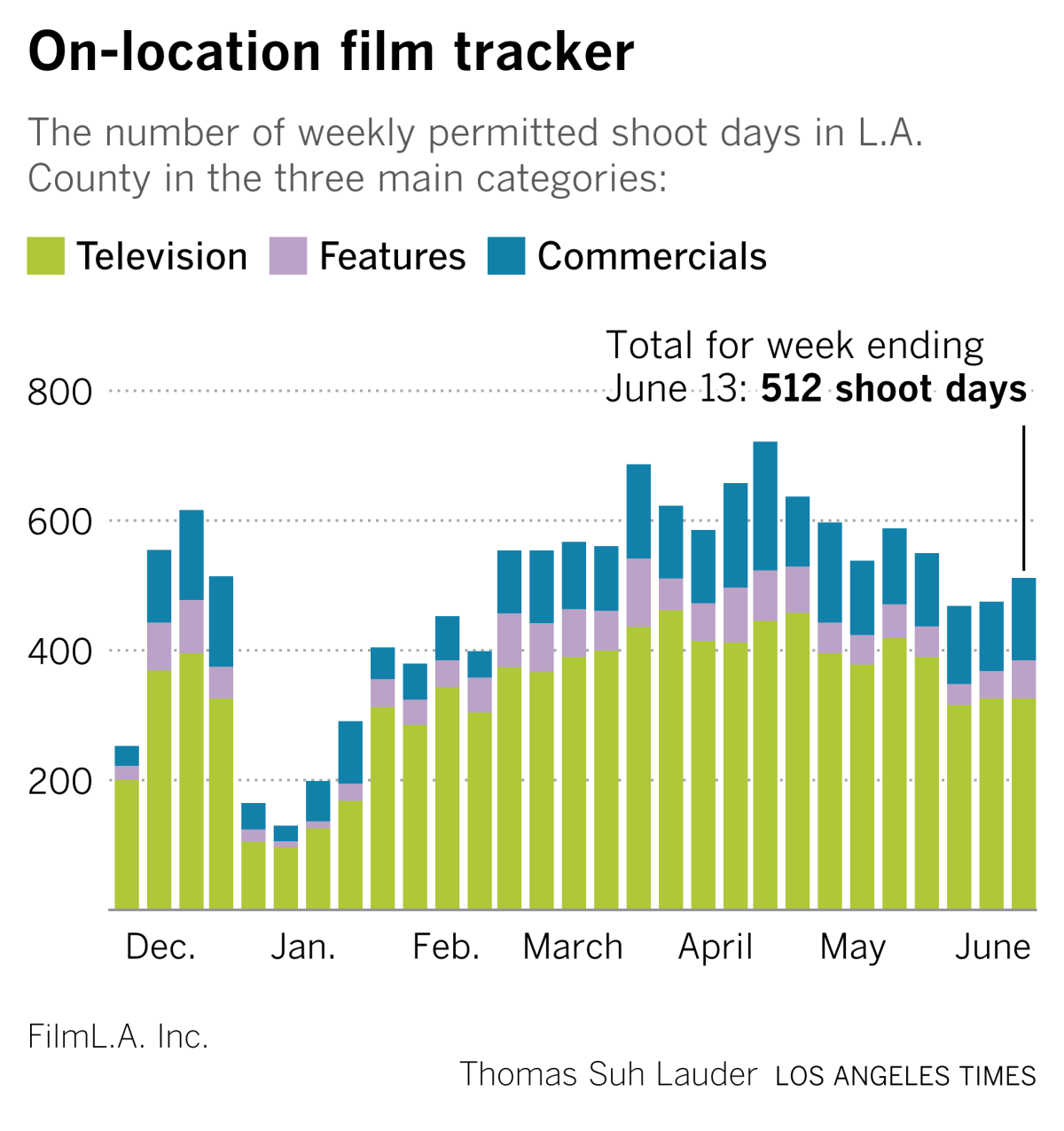Why acclaimed ‘In the Heights’ fell short at the box office

- Share via
This is the June 15, 2021, edition of The Wide Shot, a weekly newsletter about everything happening in the business of entertainment. Sign up here to get it in your inbox.
Let’s stipulate from the start that it’s not necessarily curtains yet at the box office for “In the Heights.”
It’s possible that word-of-mouth hype will spread and buoy the box office for Jon M. Chu’s adaptation of Lin-Manuel Miranda’s acclaimed New York-set musical.
The best-case scenario would be a repeat of what happened with “The Greatest Showman,” which looked DOA when it debuted in 2017 with middling reviews but went on to gross more than $170 million domestically.
But for now, Warner Bros.’s “In the Heights,” which arrived in theaters with almost nothing but raves, is a commercial disappointment after opening with a dismal $11.4 million in ticket sales, falling short of the $15 million to $20 million that box-office prognosticators expected.
It’s an unfortunate result coming after “In the Heights” was saddled with an unfair cultural burden. One byproduct of the industry’s shortcomings with inclusion is that any studio movie depicting an underrepresented group in a culturally specific way becomes a potential watershed moment.
My colleague Fidel Martinez, in his commentary on Hollywood’s persistent deficit of Latinx representation, summarized the high stakes of this $55-million movie by quoting its star, Anthony Ramos.
“We haven’t had a movie that feels like ‘Black Panther’ or ‘Crazy Rich Asians,’” Ramos told the Hollywood Reporter. “We” meaning Latinos, who consistently over-index among moviegoers despite being overlooked for on-screen roles.
“I’m not sure who decided that ‘In the Heights’ needed to be the Latinx ‘Black Panther’ or ‘Crazy Rich Asians,’” Martinez wrote. “But the discourse around the musical certainly feels like it’s our only shot at getting more of our stories on-screen.”
Let’s hope not. Latinos have nothing to prove when it comes to box-office clout. Just look at the “Fast and Furious” franchise, which has grossed more than $6 billion to date, thanks in large part to Latino audiences. (Do sign up for Martinez’s newsletter, the Latinx Files, and read The Times’ full series on the entertainment industry’s failings around Latino representation.)
That said, the tepid start for “In the Heights” is an intriguing mystery. So let’s look at the numerous competing theories for why sales sputtered.
It’s safe to guess that marketing and reviews, usually the first stop for the blame train with any given flop, aren’t the problem. According to iSpot.tv data cited by MediaPost, Warner Bros. has spent $23.3 million in national TV ads since the beginning of the year, and $9.6 million in the last month, the most of any theatrical movie over the time span. Reviews are 97% positive, according to Rotten Tomatoes.
Reviews made the case that the joyous musical, full of outdoor dance set pieces, was the exact type of movie that moviegoers should trek to the theaters to soak in — with other people(!) — after a year-plus of authorities encouraging social isolation.
So why didn’t more people go?

Despite the interest in “Hamilton,” both on Broadway and on Disney+, movie musicals remain challenging for studios. At its core, “In the Heights” is a musical centered on young romance.
Competition probably played a role. Moviegoers may have seen the trailers for “In the Heights” and decided they would rather see “A Quiet Place Part II” or “The Conjuring: The Devil Made Me Do It.” Both are franchise horror movies, a genre that has historically performed strongly with Latinos.
The opening weekend audience for “In the Heights” was about 40% Hispanic, according to exit polling data. However, at locations operated by Maya Cinemas, a chain that focuses on predominantly Latino areas, the film ranked behind “A Quiet Place II” and “Peter Rabbit 2: The Runaway.” Much of the ticket buying was concentrated in New York, indicating that the audience didn’t expand much beyond the core Broadway fan base.
And “In the Heights” came to the box office with few household names beyond that of Miranda, who has a minor role as the piragua guy. Miranda was the male lead of the Broadway production, but he made space for Ramos to give a star-making performance.
And though it has the Miranda pedigree and multiple Tony awards, “Heights” is not a huge piece of intellectual property. Miranda is a phenomenon, but “Heights” in a way still feels like the warm-up act to “Hamilton.” The movie cycled through development for years at Universal and the Weinstein Co. before it went to Warner Bros.
Betting on “In the Heights” was partly a gamble that Miranda’s power as a brand-name creator would retroactively transfer to a previous work. It would be a little like staging a Broadway version of George Lucas’ “American Graffiti” after “Star Wars” took the nation by storm. Maybe that would have worked, but it would’ve been risky.
And, of course, there’s the fact that “In the Heights” was available to stream for no extra cost on HBO Max. WarnerMedia won’t say how many people watched the debut online.
However, executives have told me that there’s not that much overlap between the audiences that watch films that debut on HBO Max and the folks who are going to theaters. Maybe there’s more cannibalization than WarnerMedia is letting on, but we don’t know.
There’s also the fact that we’re still in the midst of a pandemic, and there’s little understanding of what lingering effects COVID-19 will have on moviegoing.
People decide to avoid certain movies for all kinds of reasons. With that in mind, it would be nice if we could evaluate the performance of “In the Heights,” and Latino-focused films that come after it, on their own terms. It seems as if that’s what audiences are doing.
Stuff we wrote
— If you read one piece about Judge Judy, make it this one by Josh Getlin: “The Improbable True Story of Judge Judith Sheindlin and the Reporter Who Made Her a Star.”
— Yvonne Villarreal on the early days of “Keeping Up With the Kardashians,” which “may have started out as a copycat” but “became an unexpected billion-dollar empire that turned the clan at its center into industry titans who’ve left an indelible imprint on contemporary pop culture and reshaped the celebrity economy.”
— Warner Bros. may be in merger limbo, but at least you can take a selfie with Aquaman’s trident. Hugo Martin gives us a sneak peek of the revamped studio tour.
— Riz Ahmed wants to end Hollywood’s misrepresentation of Muslims. Here’s how the “Sound of Metal” star aims to break harmful stereotypes.
— Did I mention The Times’ Latino-Hollywood coverage? Hollywood has failed Latinos for 100 years. Here’s how to change that.
Number of the week

It’s not all gloomy at the box office. Paramount’s “A Quiet Place Part II” became the first movie to cross the $100-million box office milestone in the U.S. and Canada during the pandemic. Theater owners will point out that unlike many other recent releases, “A Quiet Place II” is available only on the big screen. It’s also a sign that box-office trends have picked up where they left off before COVID-19. Audiences love sequels and seeing horror movies with a crowd (See also: “The Conjuring: The Devil Made Me Do It”).
The Pitch: Loki, seller of SUVs

You could say that the Hyundai Tucson and Disney+ are going after a similar audience. They both want to appeal to families without alienating other potential customers.
So it’s a little funny that Disney is rolling out an elaborate promotional campaign that puts characters from Disney+ shows — “WandaVision,” “The Falcon and the Winter Soldier,” “Loki” and “What If?” — behind the wheel of the Hyundai Tucson, the South Korean automaker’s compact SUV.
Of all the big streaming services, Disney+ most risked becoming the minivan of online video: practical for people who have children but not particularly appealing to those who don’t. Marvel, and to a lesser extent, Star Wars, solve that problem for Disney+.
‘Die Hart’ with a vengeance
When people look back on how the pandemic changed the streaming business, the bizarre journey of Kevin Hart’s show, “Die Hart,” will be a helpful case study.
It premiered last year on Quibi, before the ill-fated subscription service for bite-size videos shuttered. The action-comedy then found a new home on Roku’s free, ad-supported service, where it’s described as a hit, at least by the device maker’s opaque standards.
During the pandemic, demand for content surged so much that an obscure show orphaned by one service with a particular business model could become another’s success.
This blurb originally appeared in this series: California is reopening. Here’s what that means for you.
More top stories
— Los Angeles Magazine’s profile of online “power broker” Yashar Ali has been making the rounds for its revealing details and anecdotes about high-profile friendships and bridges burned.
— Bo Burnham and the online condition. Charlie Warzel analyzes Burnham’s new Netflix special “Inside” and how it connects to the internet’s effect of “a little bit of everything, all of the time” or the way online life “flattens time and collapses context.”
— MoviePass’ operators intentionally blocked users from accessing the product they were paying for and failed to protect their data, according to the FTC. Yikes. Those responsible for the defunct app settled, but they were not hit with a monetary penalty. (THR)
— A new AMC+ satire mocks the family sitcom cliché of schlubby husbands paired with improbably beautiful wives. The New York Times highlights the most egregious examples.
— The podcasting hype house from Hell! How China’s biggest audio platform funded one man’s frat boy dreams. (The Verge)
Hollywood production
Last week’s production numbers grew slightly to 512 days, according to data from FilmLA, thanks to an increase in feature shooting.

Finally...

I am fully onboard for the Jean Smart renaissance, after “Watchmen,” “Mare of Easttown” and HBO Max’s comedy “Hacks.” Robert Lloyd has a smart essay on the very compelling season finale and why this story of an unlikely friendship works so well.
Lastly, a Baby Cousin Itt named Wasabi has won best in show at Westminster.
Inside the business of entertainment
The Wide Shot brings you news, analysis and insights on everything from streaming wars to production — and what it all means for the future.
You may occasionally receive promotional content from the Los Angeles Times.




